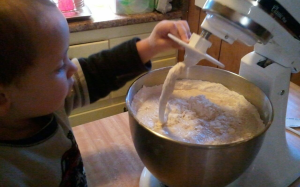I have a lot of friends whose mamas make bread. (I have more friends whose mamas buy it from the store.) Mama falls somewhere in between. She likes making it, but she doesn’t always have the time or inclination. (This is what she tells me, as I don’t know what inclination is.)
Knowing me like she does, however, she thought I’d enjoy learning how to make it. We’ve made lots of cakes and scones and cookies and even pizza dough, but I haven’t made a yeast bread yet. I have to say it’s about as scary as roasting a whole chicken: once you do it, you realize it wasn’t so bad. (It’s especially easy when you have a stand mixer, as it does all the kneading for you.) Here’s how we did it:
In a small bowl, add the yeast to the warmed water. Whisk until all the yeast is dissolved, getting into all the corners of the bowl (the liquid will foam). Let sit while you pull together the other ingredients.

Make sure all the yeast is dissolved in the water.
In the bowl of a stand mixer, pour the flours, salt, sugar, shortening, and dry milk.

I’m pretty good at getting all this stuff into the bowl. Well, most of it, anyway.
Pour in the yeast mixture.

The mixer’s really full, so start on the lowest setting. (I made it go really fast, and it was very funny.)
With the dough hook attachment, mix the dough on low setting until dough forms, 5–8 minutes. Stop the mixer and pull out a small chunk of dough. Stretch it. The dough should thin to the point of breaking, but not readily tear apart (a small hole is okay). This is called the gluten window. If the dough pulls right apart, return it to the mixer and continue mixing another 2 minutes, then recheck the dough. Mama says it’s important that you don’t overmix your dough, or you’ll overdevelop the gluten, and you’ll have tough bread. (Remember our bread pudding?)

The dough was a little frightening as it flopped around the bowl. Mama didn’t get a picture of the gluten window. (I really couldn’t see it anyway.)
Lightly grease a large bowl or cookie sheet with cooking spray or vegetable oil. Place dough in/on it, then cover with a clean dishtowel. Let it set out on the counter until it doubles in size, 1–2 hours. This is called proofing.

Holy proof!
Once the dough has finished proofing, punch it down and give it a few more kneads with your hands to get out any air bubbles. This was my favorite part! Divide the dough in half.
Lightly grease 2 standard-size (9″ x 5″) bread loaf pans and set aside.
Lightly flour a work surface and, using a rolling pin, roll the dough to about the length of the loaf pan.

The dough is really soft, so it doesn’t take but a few quick rolls to stretch it out.
With your hands, roll the dough like a jellyroll then place it in the loaf pan, seam side down. (Mama says if you wanted to add a flavor to your dough, like roasted garlic or herbs, lay them on the dough before you roll it, then your flavors will be swirled in the bread.) With a sharp knife, cut a slit, about ½ inch deep, down the length of the loaf, across the top. Repeat with second loaf. Cover the pans with the dishtowel and set aside to proof a second time.
-

-
The creases other than the slit down the middle are from the towel. Mama apologizes.
-

-
Now Mama just has to put these in the oven.
Heat the oven to 350°F. When the loaves are again doubled in size, lightly brush them with egg wash (1 egg, beaten with about 1 tablespoon of water or milk). This will give them a nice golden color. Bake in the center of the oven until an internal temperature reaches 190°F (about 50 minutes). You can see that ours got a bit dark. This was all Mama’s fault, since I’m not allowed near the oven. If your bread is getting too dark, too quickly, tent foil over it for the remainder of the bake time.
Unmold the loaves within 5 minutes of taking them out of the oven, and set on a rack to cool completely before cutting. The waiting is the hardest part, but Mama says you’ll crush all the lovely airiness of your bread if you cut it while it’s warm.

Mama says they’re a little dark and a little lopsided, but neither one of us care.
Mama declared the loaves imperfect, but still a terrific freshman attempt on my part, even though I took a nap somewhere during all that proofing.
Love, Jude
Wheat Bread
3 ¼ cup + 2 tablespoons water, 105–110F°
1/3 cup + 2 teaspoons yeast
3/4 cup whole-wheat flour
7 cups bread flour
2 tablespoons sea salt
1/2 cup sugar
4 ounces (1/2 cup) shortening
3/4 cup dry milk
Makes 2 (9″ x 5″) loaves
Note: Mama tried really hard to convert her weighted measurements to cuppage. To get as close as you can to Mama’s measures, spoon your flours into your measuring cups, rather than dipping your cups into the flour.



























